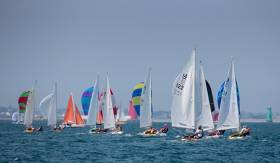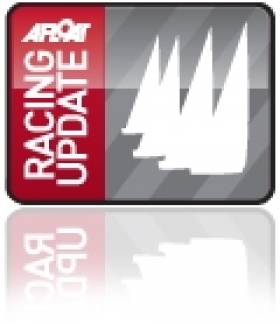Displaying items by tag: IDRA14
When you’re among friends at a major anniversary celebratory dinner for a dinghy class of national historic significance, it’s something of a gamble to allow a roving microphone to be taken into the midst of the gathering at the height of the party and allow everyone and anyone the opportunity to tell their favourite stories from seventy years of sailing and sociability involving the boats being so enthusiastically honoured writes W M Nixon.
In fact, it’s a double gamble, as you’re relying on the expectation that an extra level of tolerance will be extended to those who become over-emotional with the saltiest of language in their recollections, and at various stages you’ll be hoping that the unwritten rule will prevail that what’s said and done at such occasions stays at such occasions, provided the matter in question falls short of murder - and even that might be debatable…..
Last Saturday night’s 70th Anniversary Dinner for the IDRA 14 Class in the Royal St George Yacht Club in Dun Laoghaire was the boisterous rounding-out of a year-long celebration which has managed to take on national and international connotations. But as the idea for the class was first hatched in the Royal St George YC by the likes of Douglas Heard and Billy & Jimmy Mooney in the winter of 1945-46, with the IDRA 14s’ first race being staged by the selfsame club in the summer of 1946, there was only one possible venue for the 70th Anniversary Dinner on Saturday October 15th 2016.
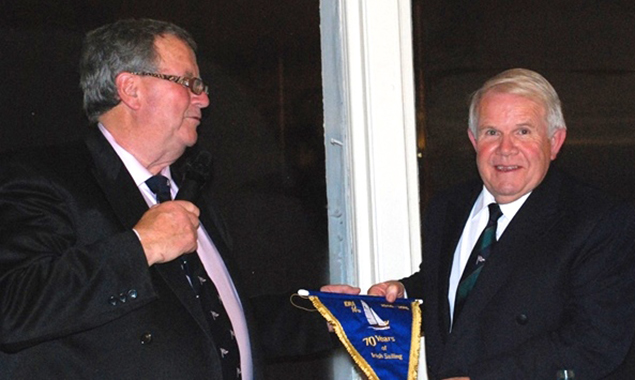
RStGYC Commodore Justin McKenna entered into the spirit of the occasion with total enthusiasm by kitting himself out in a Gala Dinner outfit that should be the envy of Commodores worldwide, complete with a magnificent bow tie which surely requires a licence for use in public. And the IDRA 14 sailors past and present from all over Ireland turned up in their droves with extra memorabilia and memories to add to the already impressive collection put in place by Class Commodore Ian Sargent and his team. Then to add the necessary gravitas to the occasion, Irish Sailing Association President David Lovegrove and his wife Kate arrived as Guests of Honour on a double basis – the President was himself a keen IDRA 14 sailor back in the 1960s.
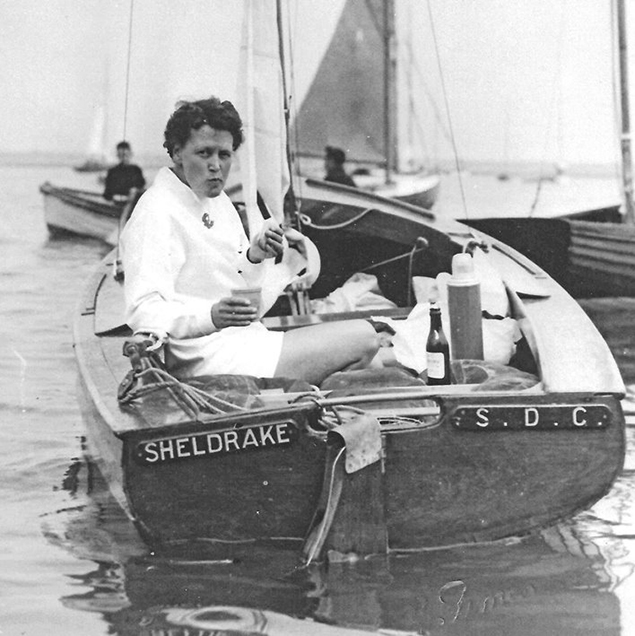 Now there’s style for you. An elegantly-kitted Mary Conn enjoys a picnic lunch aboard the IDRA 14 Sheldrake from Sutton in Dun Laoghaire Harbour before a regatta in 1952.It was an event which gave a true sense of the passage of time, for some of the more ancient stories told were well beyond the wildest reaches of Political Correctness, while the old photos revealed that on occasion the IDRA 14s were moved about the country by transport arrangements which definitely wouldn’t come through an NCT today. And it has to be admitted that in the early days, lifejackets were discarded at the earliest possible opportunity - if they’d ever been put on in the first place……
Now there’s style for you. An elegantly-kitted Mary Conn enjoys a picnic lunch aboard the IDRA 14 Sheldrake from Sutton in Dun Laoghaire Harbour before a regatta in 1952.It was an event which gave a true sense of the passage of time, for some of the more ancient stories told were well beyond the wildest reaches of Political Correctness, while the old photos revealed that on occasion the IDRA 14s were moved about the country by transport arrangements which definitely wouldn’t come through an NCT today. And it has to be admitted that in the early days, lifejackets were discarded at the earliest possible opportunity - if they’d ever been put on in the first place……
But in all and in every way, it was a hugely memorable night for a very special class which deserves every minute of the celebration.
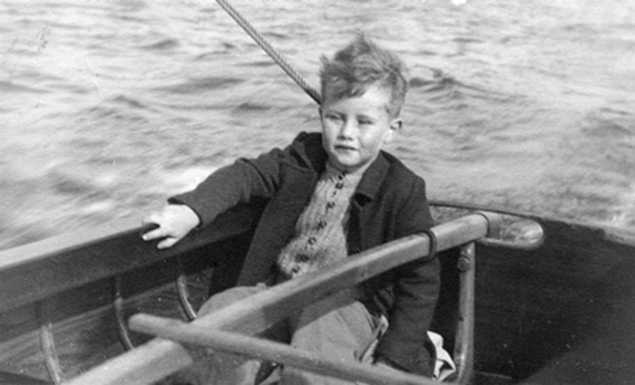 Once an IDRA 14 sailor, always an IDRA 14 sailor…… A very young (and admittedly lifejacket-less) Ian Sargent aboard one of the many IDRA 14s built by his father Charlie. Charlie Sargent was one of those instrumental in bringing the class into being, and his “amateur-built” boats were often superior to those of professional builders
Once an IDRA 14 sailor, always an IDRA 14 sailor…… A very young (and admittedly lifejacket-less) Ian Sargent aboard one of the many IDRA 14s built by his father Charlie. Charlie Sargent was one of those instrumental in bringing the class into being, and his “amateur-built” boats were often superior to those of professional builders
IDRA 14 Class Celebrates 70 Years
IDRA 14 sailors will be involved in a host of activities this year to celebrate the 70th Anniversary of the class. A series of events, both on and off the water, will be held to mark the birth of the class which held its very first race in Dun Laoghaire 70 years ago.
The line-up of activities for 70th Anniversary will culminate with a Gala Dinner this Autumn in the Royal St George Yacht Club, the club which hosted the first IDRA 14 race. With IDRA fleets racing actively in Clontarf and Sutton, as well as Dublin Bay Sailing Club, the birthday celebration events will be taking place on both sides of Dublin Bay, including a special Birthday Weekend in Clontarf Yacht and Boat Club in early September.
Another highlight during birthday celebration of the class is set to be the launch, proposed for June, of first wooden-hulled IDRA 14 to be built in almost 40 years. In a class which prides itself as being “classic and progressive”, both wooden hulled IDRA 14s and GPR boats compete, although the IDRA class has long since dropped the centreboard weights in the original design, to bring in the trapeze and spinnaker.
The 70th Anniversary of the IDRA 14 will also be marked throughout all the class’s regular calendar events, including regattas in Dun Laoghaire, Sutton and Clontarf (with IDRA sailors often sailing across the bay in groups to support each other’s events), as well as the Rostrevor Northerns on the June Bank Holiday weekend and the IDRA 14 Nationals, being held in Dromineer, on Lough Derg, this year.
The IDRA 14 Class came about when a group of sailing enthusiasts, who had been volunteering together in Slua Muiri, the Irish Navy Reserve force, during the Second World War, decided to set up an organisation to promote dinghy racing in Ireland. One of the first tasks of the newly formed Irish Dinghy Racing Association was to have an Irish one design dinghy which could be raced nationally. There were a number of one-design dinghies, including Waterwags and Mermaids and the Shannon-One-Design, but no one class was raced everywhere.
The new association settled on the design of the Irish naval architect, George O'Brien Kennedy, with some adjustments being made to his prototype, the “Fuss”. The class was given the name IDRA 14 after the new association, with the intention that there would also be an IDRA 18 and other length dinghies to follow. The class went on to be raced in as many as 17 different clubs in Ireland. The Irish Dinghy Racing Association became renamed the Irish Yachting Association and eventually the Irish Sailing Association, now also having a history going back 70 years.
Ocean Energy, Angling & Fishing Expo in Seascapes Podcast
Hello and welcome aboard this weeks edition of your maritime programme, we have music from Molgoggers, we preview the Lewis Symposium presented by MaREI – Ocean Energy; Theory, Practice and Integration hosted by the Environmental Research Institute Beaufort Building, University College Cork by visiting the Seascapes archive and hearing from Emeritus Professor Tony Lewis ....the remarkable HMS Caroline the Battle of Jutlands only afloat survivor in Belfast soon to open as a heritage visitor attraction, Fergal Keane visits the annual Angling Expo in the National Show Centre held last weekend ..... and our competition for copies of “This Is the Burren” by photographer Carsten Krieger courtesy of The Collins Press; ....First here on Seascapes to the Raidio na Gaeltachta Studios in Derrybeg near Gweedore to hear from Hugh Bonner of Mara Media who publish The Irish Skipper and host the Skipper Expo with over one hundred exhibitors in Galway next weekend on Friday 4th and Saturday 5th March at The Galway Bay Hotel...
The Winter lecture 2015/16 season of the Glenua Sailing Centre continues with a double lecture programme at the March meeting entitled: ‘The Sea From Two Perspectives’.
The illustrated lectures will take place on next Thursday 3 March (20:00hrs) at the Poolbeg Yacht & Boat Club, Ringsend, Dublin. There will be an entry fee of €5 in aid of the R.N.L.I
The first lecture, “Art and The Sea - An Enduring Fascination” will be given by Jessica O’Donnell who is Collections Curator at Dublin City Gallery The Hugh Lane. Jessica is a graduate of Trinity College, Dublin and the University of St Andrews.
Jessica’s talk will explore how artists have been captivated by the sea from many perspectives including how the Impressionists loved portraying people at leisure by the sea; how safeguarding the freedom of the seas was represented in artworks commissioned as war time propaganda; to contemporary artists whose fascination with the sea and marine life continues to inspire.
The second lecture is entitled, “Putting Eyes In The Deep Ocean” by Dr Fiona Grant, Ocean Science & Information Services (OSIS), Marine Institute, Ireland. Fiona began her studies in geology before going on to specialise in marine geophysics and earth system dynamics. Her first job was as conservation coordinator for wild salmon and sea trout before taking responsibility for research infrastructures in the Marine Institute.
Dr Fiona Grant will focus on some of the challenges in observing the deep ocean environment, how to harness ocean energy in Galway Bay and present some of the latest results from studies in the Atlantic Ocean.....
The annual Ireland Angling Show was held in the National Show Centre in Swords in Dublin last weekend. ..........Fergal Keane went along for Seascapes.
Hi Marcus,
It's nearly 3 years since you put out a call on Seascapes to help us find people who had built IDRA 14 dinghies in the past or had plans that we didn't know about.Well, we're now coming towards the end of our project! We did meet with some listeners to your programme, who got in touch during that time and visited our project. Thought you might like to know how we're doing.
As we enter into the 70th anniversary year of the IDRA 14 Dinghy, we're delighted to be able to announce the launch date for the new wooden clinker-built IDRA 14 dinghy, being built in Clontarf, the first to be built in well over 35 years.
Look at it now............Riveting completed, floor bearers in place, spinny shute in place, foredeck on - we're ready now to put the deck on and close up the boat! :-) Find out more in our latest update.
Next to Emeritus Professor Tony Lewis of University College Cork , back in October of last year we were in Croke Park for an Ocean Energy Conference and we spoke to Tony ...
On Monday and Tuesday the Environmental Research Institute Beaufort Building hosts MaREI –The Lewis Symposium on Ocean Energy : Theory Practice and Integration at the National Maritime College of Ireland .....speakers will include Professor Tony Lewis ; Eoin Sweeney on Marine Renewables in Ireland ; Professor Stephen Salter , Emeritus Professor University of Edinburgh ; Professor Trevor Whittaker , Queens University Belfast on the Industrial History of Ocean Energy and Professor Alistair Borthwick , University of Edinburgh on tides and Tidal Power , we’ll have more detail on the speakers and topics at the Lewis Symposium and we’ll have a full report on Seascapes next week....,.
The War at Sea is rarely considered when discussing the impact of the First World War but, although it involved far fewer men on the front line, keeping the seas safe and the vital supplies flowing to feed the Army and the people of Britain and Ireland cannot be overlooked. From across Ireland over 10,000 men served in the Royal Navy, but many tens of thousands more served in the merchant fleet, continued to fish despite the hostile submarine threat, provided essential rescue services off our coasts and maintained the essential industries directly linked to the sea.
31st May 2016 is the Centenary of the Battle of Jutland, which was the most significant naval engagement of WW1. This is the chosen date to mark the contribution of all involved in war and life at sea 1914 – 1918 with a Commemoration to the Irish Sailor in the Great War. The event will be run in Belfast next to Jutland’s only afloat survivor, HMS Caroline, and will include her official opening as a heritage visitor attraction. The commemoration will connect people in maritime activity a hundred years ago with descendants, and to those engaged in similar activity today.
New Clontarf Yacht & Boat Club IDRA 14 Clinker Dinghy Nears Completion
As the venerable IDRA 14 dinghy prepares for its 70th anniversary year, a launch date has been announced for the new addition to the clinker fleet, being built in Clontarf Yacht & Boat Club, the first in over 35 years.
Fourteen Number 166 will be named on 25th of June with a celebratory drinks reception in the Dublin Bay clubhouse, marking over a year in build under the guidance of Ronan Melling.
Riveting on the new wooden dinghy has recently been completed, floorbearers in place, spinny chute in place, foredeck on - and the construction team ready now to put the deck on and close up the boat!
The build team are looking for a name for the new boat. The new name will continue the IDRA 14 tradition of bearing a name beginning with the letter 'C' to denote her home port of Clontarf. Leave your suggestion in the comment box below.
It's taking shape! The IDRA newbuild is progressing well. #sailing @Tarfboatbuild pic.twitter.com/9Hpr4IXQL9
— Clontarf Y&BC (@TarfYBC) January 14, 2016
O'Neill and O'Hara Win IDRA 14 Nationals
28 boats made the 2010 IDRA 14 dinghy national championships something of a class record when they set sail at Lough Ree YC. The previous best was 26 in 2006). All six championship races and the crew's race were completed. Pat O'Neill and Jim O'Hara from Clontarf Yacht and Boat Club were first overall sailing Delos II. A special (liquid!) prize was awarded to 14/4 'Dusk' (Gary & Andy Sargent), whose rudder stock collapsed in very heavy winds during the first race. They took advantage of the Race Officer's postponement of the second race to travel back to Dublin, make a new stock, and get back to LRYC in time to come second in the event. Full results below:
IDRA 14ft CLASS NATIONAL C'SHIP – Lough Ree YC 11/14th Aug 2010
Overall Results:
Gold Fleet
1st 14/15 'Delos II' Pat O'Neill & Jim O'Hara CY&BC
2nd 14/4 'Dusk' Gary & Andy Sargent CY&BC/HYC
3rd 14/125 'Slipstream' Alan Henry & Simon Revill SDC/HYC
Silver Fleet
1st 14/161 'Dart' Pierre Long & David Long DMYC
2nd 14/122 'Diane' Fergal O'Flaherty & Brian Murphy DMYC
3rd 14/136 'Sea Urchin IV' Gordon Stirling & Barra O'Donoghue CY&BC
Afloat Magazine Youth C'ship Trophy
14/136 'Sea Urchin IV' Gordon Stirling & Barra O'Donoghue CY&BC
Transom Trophy
14/1 'Error' Jim Lambkin & Wendy Rudd SDC
Mullingar Trophy
14/124 'Squalls' Stephen Harrison & Stephen Johnston DMYC
Endeavour Trophy
14/107 'Spray' Joanne Sheehan & Therese Clarke RStGYC
'De Maast' Trophy
14/6 'Dolphin' Hugh McNally & Ian Byrne SDC
Old Oak Trophy
14/138 'Sapphire' Lorcan O'Sullivan & Deirdre Duignan DMYC
Crew's Race Trophy
1st 14/125 'Slipstream' Simon Revill HYC
2nd 14/163 'Second Chance' Gerard O'Sullivan SDC
Individual Race Prizes
Race 1 14/15 'Delos II' Pat O'Neill & J. O'Hara CY&BC
Race 2 14/38 'Starfish' Alan Car & Aoibhin de Burca SDC
Race 3 14/125 'Slipstream' Alan Henry & Simon Revill SDC
Race 4 14/4 'Dusk' Gary Sargent & Andy Sargent CY&BC
Race 5 14/143 'Chaos' Julie Ascoop & Heather Keenan CY&BC
Race 6 14/140 'Dunmoanin' Frank Hamilton & Marjo Moonen DMYC



























